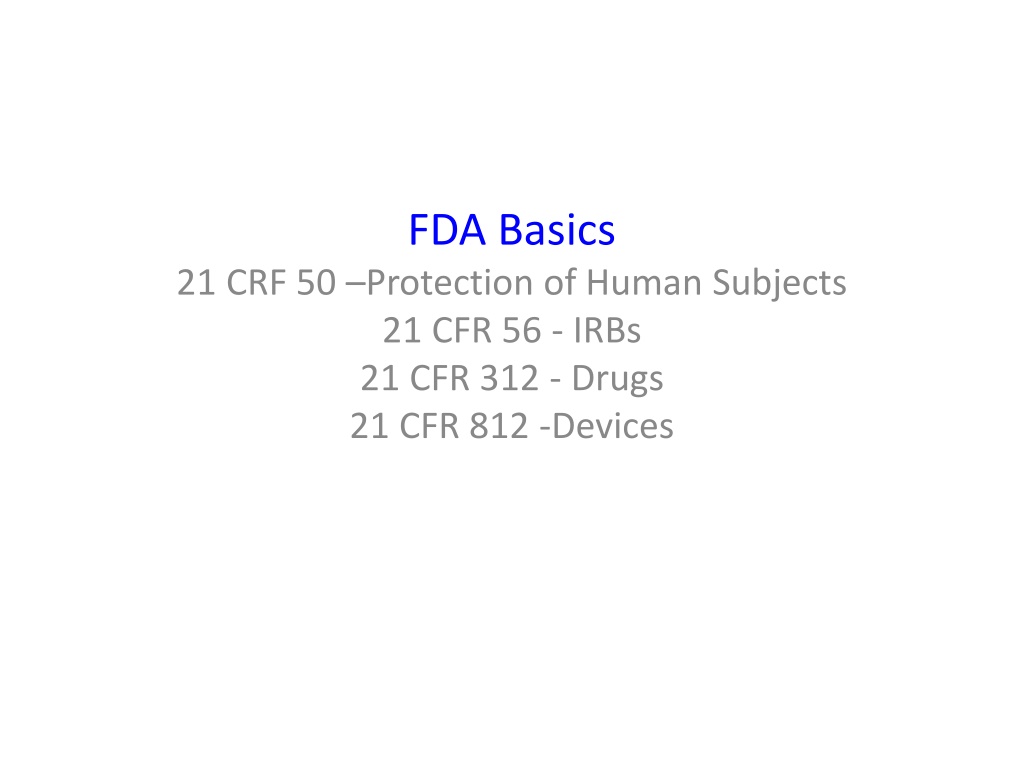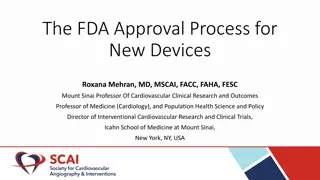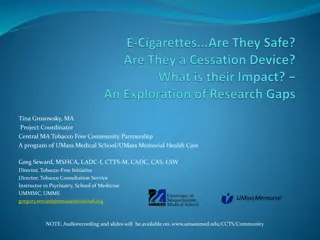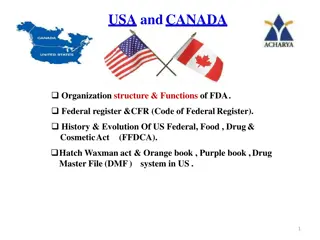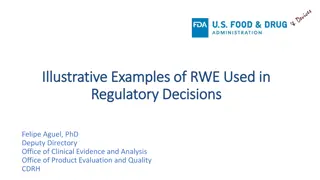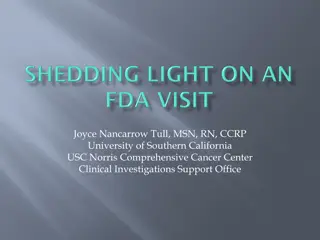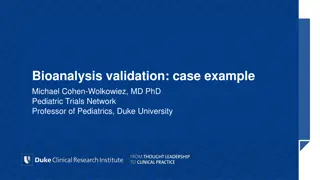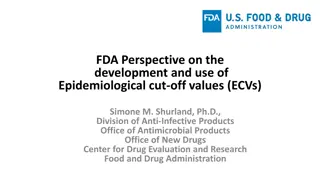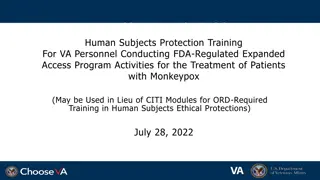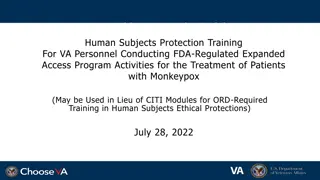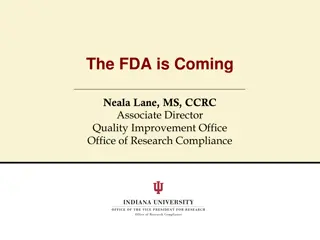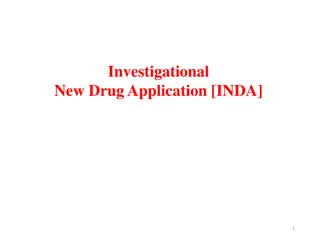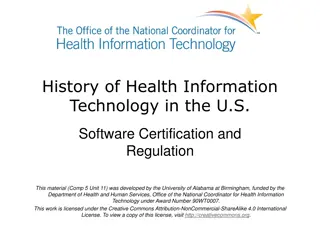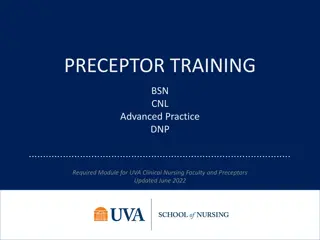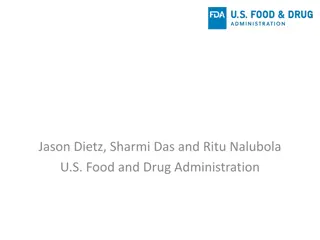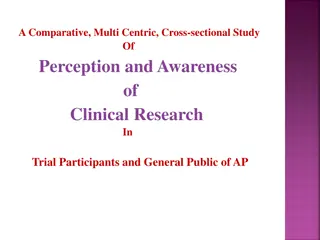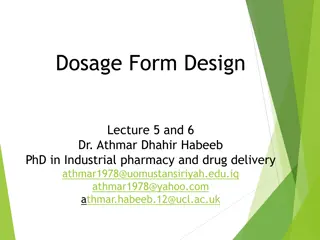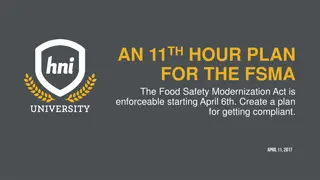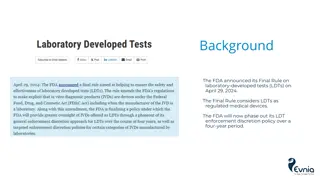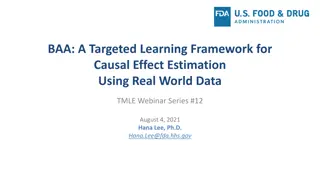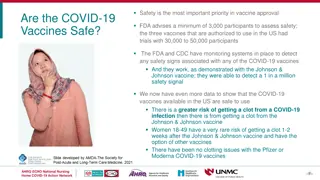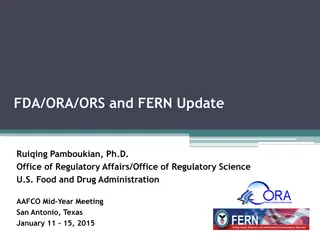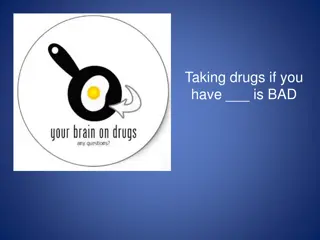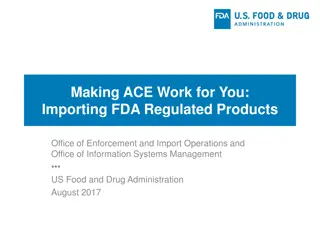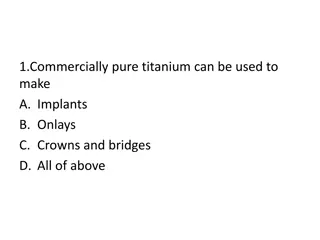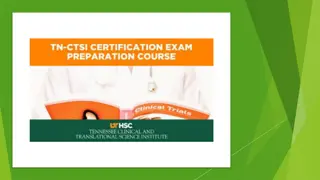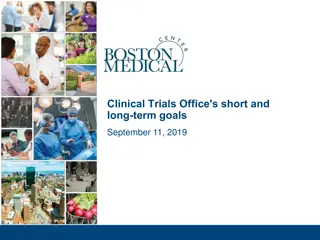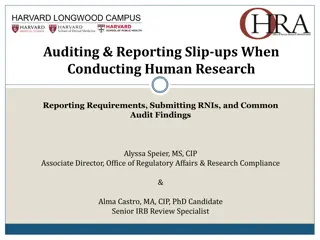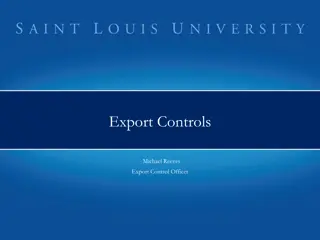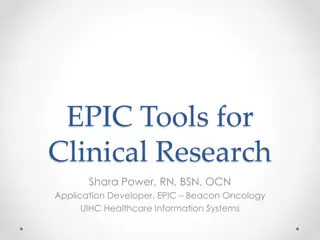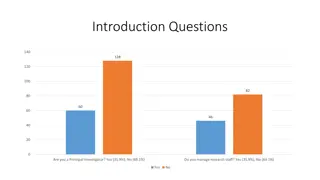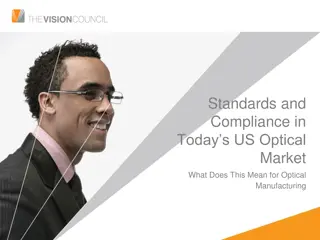Understanding FDA Regulations in Clinical Research
FDA regulations in clinical research cover the protection of human subjects, IND/IDE requirements, risk determinations, application processes, and what falls under FDA regulation. It distinguishes between FDA-regulated activities and those not regulated, such as medical record reviews. The scope includes drugs, devices, supplements, botanicals, and biologics. The regulations define human subjects and research, with limited waivers for consent. Compliance is crucial to avoid penalties under the FD&C Act related to adulteration or misbranding, emphasizing interstate commerce and market approval.
Download Presentation

Please find below an Image/Link to download the presentation.
The content on the website is provided AS IS for your information and personal use only. It may not be sold, licensed, or shared on other websites without obtaining consent from the author. Download presentation by click this link. If you encounter any issues during the download, it is possible that the publisher has removed the file from their server.
E N D
Presentation Transcript
FDA Basics 21 CRF 50 Protection of Human Subjects 21 CFR 56 - IRBs 21 CFR 312 - Drugs 21 CFR 812 -Devices
What we will cover: What is FDA regulated IND/IDE Device Risk Determination NEW Application Supplements/Checklists General process
So, what is FDA regulated? Conducting research with drugs, devices, supplements, botanicals, or biologics Includes those that have received FDA approval as well as investigational items
Some examples of NOT FDA regulated Medical record reviews Cost effectiveness and quality improvement activities Drug and device registries Studies of surgical techniques that are only evaluating a new technique
The FDA regulations are different Human subject not defined by identifiability Means an individual who is or becomes a participant in research, either as a recipient of the test article or as a control. A subject may be either a healthy individual or a patient.
The FDA regulations are different Research = clinical investigation Means any experiment that involves a test article and one or more human subjects
The FDA regulations are different Engagement? Nope. Screening Activities? Nope. Waivers? Yes, but limited. Recently allowed for a waiver of consent for minimal risk studies (akin to HHS)
Why such a large scope? The Food, Drug, and Cosmetic Act ("FD&C Act") generally prohibits the manufacture, delivery, use, receipt or sale of any drug or device that is "adulterated" or "misbranded To avoid civil and even criminal sanctions for adulteration or misbranding, an Investigational New Drug application (IND) or Investigational Device Exemption (IDE) may be required It s really all about interstate commerce and getting item to market
Start with the assumption that any research involving a drug, medical device, biologic, or supplement is subject to FDA regulations
So now what? You confirm or invalidate this assumption during pre-review using the: Application materials provided by the researcher WORKSHEET: HRP-310: Human Research Determination WORKSHEET - HRP-306: Drugs or HRP-307: Devices
Exemptions? What? Some research is exempt from FDA human subject regulations. Such as: Investigations that occurred before July 27, 1981 and was not subject to IRB review under FDA regulations before that date Emergency use Taste and food quality evaluations
But some other is exempt from additional FDA regulations Is an IND or IDE needed? Additional FDA regulations do not apply 21 CFR 50 and 56 still applies IND exempt IDE exempt
IND/IDE exempt FDA requires sponsors /sponsor-investigators to determine whether one is needed Submit an IND/IDE application to the FDA Submit SUPPLEMENT: Drugs, Biologics, Botanicals, and Supplements OR SUPPLEMENT: Devices to the IRB It is NOT the responsibility of the IRB to determine whether an IND/IDE is needed (except for devices, but we will get to that)
IND exempt examples Legally marketed drug being used on-label Not being used to support a change in labeling Does not increase risk to subjects Placebos In-vitro diagnostic biological products Bioavailability/bioequivalence studies
IDE exempt examples Transitional or equivalent device Diagnostic device Not being evaluated for safety or effectiveness Custom device not being evaluated for safety or effectiveness
What if the IRB disagrees? The IRB has the authority to require the researcher and/or sponsor to provide or obtain confirmation from the FDA
Lets get back to devices The FDA requires the IRB to do a risk assessment of devices If non-significant risk no IDE is needed If significant risk IDE is needed
How does the IRB make a risk determination? Researcher must provide sufficient information Researcher s risk assessment and rationale Sponsor s risk assessment and rationale FDA determination (only when an IDE application has been submitted) FDA Significant Risk determination trumps the IRB FDA Non-significant determination IRB may agree or disagree
IRB risk determination considerations If a risk assessment has already been made Risk determination for other uses of the device Sponsor s risk assessment and rationale Researcher s risk assessment and rationale Procedures Population Review of the device by other IRBs
Non-significant risk device examples Conventional Gastroenterology and Urology Endoscopes and/or Accessories Magnetic Resonance Imaging (MRI) Devices within FDA specified parameters Daily Wear Contact Lenses and Associated Lens Care Products not intended for use directly in the eye (e.g., cleaners; disinfecting, rinsing and storage solutions) Digital Mammography
Significant risk device examples Surgical Lasers for use in various medical specialties Cardiac Bypass Devices Auditory Brainstem Implants Dialysis Delivery Systems Injectable Collagen
The determination has been made Documentation using the CHECKLIST HRP- 418: Non-Significant Risk Determination Communication To the researcher To the sponsor To the FDA (responsibility of sponsor)
IND/IDE exempt vs. needing an IND/IDE vs. NSR IND/IDE exempt Must follow 21 CFR 50 and 56 IND/IDE needed Must follow 21 CFR 312 (drugs et al) and 21 CFR 812 (devices) Non-signification risk determination Must follow abbreviated regulations
If FDA regulated Additional consent form elements: FDA review of records Clinical trial registration Risk information Waiver of consent Not only limited to emergency research Harmonizes with HHS Waiver of documentation of consent More limited than HHS
If FDA regulated Items made here IRB may require information about the manufacture Consultation with HU Risk Management or related Control of investigational items Review plan of control, tracking and handling Records Maintain records about the use of the item, including records of receipt, use, or disposition Where obtained IRB has authority to require use of local services
Enforcement Discretion (or how I learned to love the FDA regulations) In vitro diagnostics Not identifiable How to obtain consent? Personal importation Allowed to bring a 3-month supply of drugs from other countries that are not FDA approved Still violates federal law
FDA mantra Does it involve an item ? Drug (a substance (other than food) intended to affect the structure or any function of the body ) Device (an instrument, apparatus, implement, machine intended for use in diagnosis of disease or other conditions ) Supplement (product (other than tobacco) that is intended to supplement the diet ) Botanical (finished, labeled product that contains vegetable matter ) Biologic (virus, therapeutic serum, toxin, vaccine)
FDA mantra Is it FDA regulated? Clinical investigation Includes human subjects (just say yes to this if FDA regulated) USE - WORKSHEET: Human Subjects Research (whether IRB review is needed) USE - WORKSHEET: Human Subjects Regulations (whether FDA regulations apply)
FDA mantra Is it exempt from FDA human subject regulations? definition of exempt (item 5.2.2 FDA- Regulated Research SOP) Custom device (item 5.2.1 FDA-Regulated Research SOP)
FDA mantra Is it exempt from additional FDA regulations (IND/IDE needed)? USE WORKSHEET: HRP-310: Human Research Determination USE WORKSHEET - HRP-306: Drugs or HRP- 307: Devices
Questions? This is a rhetorical question
